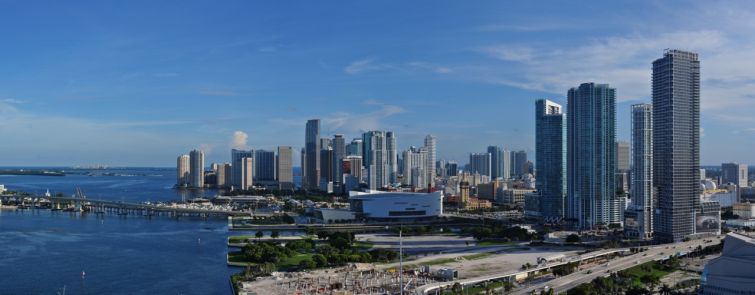Have New York Investors Found the Next South Beach?
By Ken Krasnow October 25, 2016 4:03 pm
reprints
Is Downtown Miami—home to historic Flagler Street—the next South Beach? For decades, public and private investment has avoided Downtown, where buildings of historic value were decaying and much of the available retail space was leased to tenants hawking luggage, electronics and cheap clothes. While navigating Flagler Street, particularly at nighttime, you may find it hard to imagine that Downtown Miami could duplicate the renaissance that South Beach’s Art Deco district experienced nearly three decades ago. But the signs forecasting such a future are emerging.
In the last two years, investors have acquired $1.5 billion of real estate along Flagler Street and surrounding streets. Almost half of that capital comes from New York investors, who have acquired at least 1.3 million square feet of building space and at least 1.1 million square feet of land between the Miami River and Northeast Sixth Street and between I-95 and Biscayne Bay.
That is exactly how the South Beach transformation—from a crime-infested neighborhood to one of the world’s finest destinations—took shape. In the 1980s “Miami Vice” era, Tony Goldman, Craig Robins, Mel Schlesser and Bob Christoff, all New York developers, led a revival of Miami’s South Beach district by acquiring crumbling Art Deco buildings, restoring the historical architecture and repositioning them as hotels, restaurants, street cafes and apartments.
Today, led by Moishe Mana, historic Downtown Miami is emerging as New York’s newest borough fueled by the re-urbanization of the urban core.
Since 2014, Mana, a Miami transplant from New York, has acquired more than 40 properties worth over $300 million on or near Flagler Street. His investments are nearing the critical mass necessary to bring meaningful change to the area. Mana recently retained internationally recognized architect Bernard Zyscovich to create a design that promotes urban living.
Since Mana began his buying spree in 2014, other New York investors have followed, including Edens Investment Trust, Ashkenazy Acquisitions, Brickman, East End Capital and KAR Properties. Property values are reaching levels never witnessed and a new generation of businesses, including Lost Boy Dry Goods, Supply & Advise, Pawn Broker at the historic Langford Hotel, Manna Life Food and Jar + Fork are capitalizing on the area’s renaissance.
Downtown Miami is one of the few pedestrian-oriented neighborhoods in Miami as nearly 200,000 office workers and visitors traverse its streets. The area also possesses one of the highest concentrations of luxury residential units in the world. In the last five years, Downtown Miami’s population jumped by 29 percent and is expected to increase by 20 percent each year. The re-urbanization of Miami’s urban core is just beginning.
It is no coincidence that New York investors consistently rediscover South Florida’s hidden real estate gems. They understand the value of neighborhood revitalization, repositioning historic properties and acquiring assets early on in the process. Think Soho, Tribeca and the Meatpacking District, among numerous other revitalized New York City neighborhoods.
The demand for assets on Flagler Street becomes more apparent when families and multi-owner trusts agree to sell. That’s the case of the Alonso family’s Habitat Development Corporation, which owns the historic Walgreens building at 200 East Flagler Street. The family decided to put the property on the market last month after the restoration of the landmark attracted a flurry of unsolicited purchase proposals.
The Art Deco five-story building currently contains La Epoca, Miami’s most historic department store. The property’s historic designation also allows for the sale of Transfer of Development Rights (TDRs) totaling 244,755 square feet.
The building’s sale also coincides with the redevelopment of Flagler Street, which is undergoing a $13 million facelift. The public-private partnership—the City of Miami, the Miami Downtown Development Authority and landlords along Flagler Street—plans to restore the thoroughfare’s position as a commercial anchor for Downtown Miami by improving the pedestrian experience, extending and leveling sidewalks, implementing centralized valet parking and adding new lighting and greenery. The renovation is scheduled to be completed by 2017.
It took more than a decade of behind-the-scenes work to set South Beach on a successful path. Downtown Miami is on its way. It will evolve into the next great Miami neighborhood because a group of visionaries have grasped the potential of an area surrounded by some of the country’s largest mixed-use developments, including Brickell City Centre, Miami Worldcenter and All Aboard Florida’s Brightline. Because of its proximity to several Metromover stations, the zoning for that area allows much higher density and larger projects. That creates the right conditions for a live, work, play environment, and New York investors see the potential, just like they did three decades ago in Miami Beach.
Ken Krasnow is the South Florida market leader for Colliers (CIGI) International. He has more than 30 years of experience in the commercial real estate industry. He can be reached at ken.krasnow@colliers.com.


